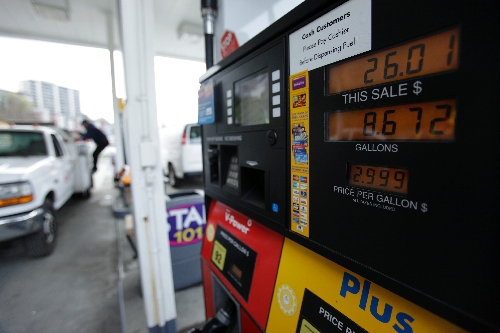Rising price of gasoline sparks concern

Gasoline prices are soaring toward $4 a gallon, a threshold that some analysts say will damage the fragile economic recovery, maybe even in Las Vegas.
Higher prices saddle businesses with higher transportation costs that they must swallow or pass along to already strapped customers. As gasoline costs rise, consumers are left with less money to spend elsewhere. And there is evidence that the hike at the pump is beginning to push drivers off the road.
The biggest danger to the local economy would come from Southern California, which has consistently been the home of one-fourth of the visitors, according to annual surveys by the Las Vegas Convention and Visitors Authority. California’s average price per gallon for regular gasoline was $4.191 Friday, AAA said in its Daily Fuel Gauge Report.
“I have not seen an effect (for Las Vegas) yet and I don’t think the current price will be a problem,” City National Bank senior economist Perry Wong said.
The repeat visitors will worry about the extra expense and others will be drawn by the prices for hotel rooms and other vacation components that have fallen in the past three years.
By his estimate, prices for regular gasoline would have to cross $5 a gallon before they significantly dented traffic.
During the last run-up in gasoline prices in 2008, traffic at the state line in Primm dropped 5.3 percent. Last year, the car count rose 2.6 percent but slowed to 0.7 percent for the first two months of 2011.
Three years ago, Wong said, the entire economy was sliding. But now, he said, the economy has started to grow again in many parts of the country.
But Sung Won Sohn, the Los Angeles economist who sits on the board of Western Alliance Bancorporation, the parent for Bank of Nevada, has started to see the effect. Various freeway traffic counts he monitors have declined in recent weeks as pump prices rose.
“The higher price of gasoline is beginning to bite,” he said. “But what has happened so far is that consumers think this has all happened before and come down again so they think it is temporary. They are not changing their driving habits a lot.”
A fundamental change could take a couple of years, he estimated.
While Las Vegas prices for hotels, restaurants and other attractions have dropped, he noted that the regional economy is much weaker than it was three years ago so that any contraction created by energy prices would bite harder.
Steven Brown, the director of the Center for Business and Economic Research at the University of Nevada, Las Vegas, expects the erosion of people’s bank accounts by weeks or months of paying more for gasoline at home to hurt the visitor industry more than just the transportation price of getting here.
When slower economic growth is added to the mix, “It’s all bad news,” he said.
There will be some people, he added, who might scrub the vacation in Aruba and take a less expensive one in Las Vegas, but that is a smaller group than those who might stay away or spend less once here.
He predicts that the price per gallon will rise another 10 to 15 cents by Memorial Day.
The average price for regular unleaded gasoline in Las Vegas was $3.894 a gallon on Friday, according to AAA’s Daily Fuel Gauge Report. That’s up 1.2 percent from $3.814 a week ago and up 5.7 percent from $3.814 a month ago, AAA said.
Prices have risen so high and so fast that some stock market analysts predicted a sell-off in the short term. On Friday, the benchmark crude oil price closed at $109.66, up $1.55 a barrel, after a week of mixed ups and downs.
Gasoline prices “are going to have a very profound effect on the economy,” said Peter Morici, a University of Maryland economist. Morici and other national economists warn that higher prices could be here to stay.
Gasoline prices peaked in June 2008, when a gallon of regular sold for an average of $4.27 in Las Vegas. Some analysts fear prices could soon approach that level again as gasoline demand rises in the warm-weather months.
Nearly three-fourths of Americans say higher prices could slow their spending in other areas in the months ahead, according to a Deloitte survey of consumers’ spending intentions.
Motorists are driving less already because of the increasing prices.
“We are seeing some deterioration in U.S. motor gasoline demand … as pump prices near $3.75 a gallon,” which is when demand got soft in 2008, Goldman Sachs analyst David Greely said. “As the market moves to higher prices, the likelihood that you’re going to weaken demand increases.”
Bill Simon, chief executive of Wal-Mart U.S., said recently that the retailer sees fewer customers when gasoline prices begin to rise, because its mammoth stores are typically farther away than local grocery and convenience stores. But as the spike continues, customers begin consolidating shopping trips and are more likely to visit just Walmart instead of a handful of smaller retailers, Simon said.
The Washington Post contributed to this report.












